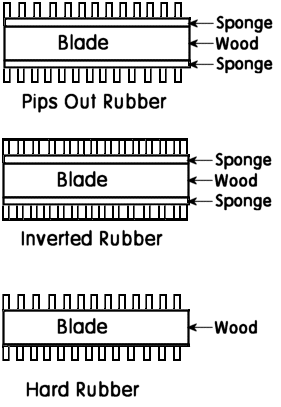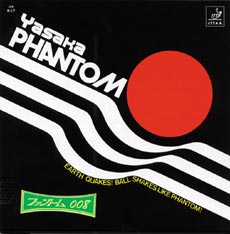STIGA DESTROYER [BLACK, 1MM SPONGE]


In my view the best all-round rubber. Destroyer gives excellent spin reversal on chops: at least as much as 008, and nearly as much as Super Defence or Super Special. The effectiveness of chops is increased by the fact that the ball, when it hits the opponent's side of the table, will often 'die' or 'hold up'; that is, it will suddenly lose momentum. This loss of momentum, combined with the spin reversal, can make it difficult for the opponent to loop again: a tired, hesitant or lazy loop against Destroyer will usually go into the net. The rubber also seems to reward good shot-making: a positive chop with a strong downwards arm movement will produce excellent results against virtually any topspin ball, but a lazy or negative chop will be ineffective. This I think encourages a good chop style. Closer to the table, blocks with Destroyer produce very good spin reversal, and are reasonably consistent. Small chop-blocks seem to work best, hit before or at the peak of the bounce; quasi-sidespin blocks in the manner of Feint Long II are inconsistent. Lifting against topspin is consistent, and the balls produced are confusing for the opponent (especially if you use both the forward scoop and the sidespin scoop read this page for a description). Pushes stay low, with good spin reversal; this can force the opponent to loop out or push high. Highly recommended for those who mainly chop away from the table, and for those who play close to the table with a focus on lifting and chop-blocking. About the only disadvantage is that counter-hitting with Destroyer is hard to do consistently: one or two counter-hits in a row is about all you can expect. (Rumour has it the 1.5mm sponge version is outstanding for blocks and counter-hits, but I haven't tested this myself.)
TIBHAR EXTRA LONG [BLACK, NO SPONGE]
I only had a brief hit with this, so cannot give a detailed review. A few things to note, however. First, the name is misleading: the pimples are not "extra long" at all, but medium long 1.5mm x 1.5mm. Second, as a result, there is not much "wobble", and only moderate spin reversal (even with no sponge). Third, attacking is possible, but will produce a flat/"sink" ball of slow to moderate speed rather than confusing spin; hence opponents will not be overly troubled. Fourth what is perhaps both a strength and a weakness the rubber is slow, steady, predictable and controllable. Thus it is best suited to players who prefer a consistent, away-from-the-table chopping/retrieving game with very occasional attacks. The lack of spin reversal means blocks and chops will not set up many attacking opportunities (because the opponent will not be forced to push); and the lack of speed makes it unsuited to fast, close-to-the-table attacks.
TIBHAR GRASS DEVIL [BLACK, 1MM SPONGE]

Again, I only had a brief hit with this, so cannot give a detailed review; but two things were clear. First, it is outstanding for attacking against backspin: any backspin ball can be lifted/scoop-attacked hard, consistently and unlike the rather gimmicky Grass Special 3000 with good control. Grass Devil would thus be outstanding for close-to-the-table play. Second, however, it is not very good for chopping. With most long pimpled rubbers, the ball, when you chop, will bounce on the opponent's side of the table and then "die" or "hold up" that is, it will fairly suddenly lose momentum. It is this sudden reduction in momentum which, in conjunction with backspin, can make it difficult for the opponent to loop again. But Grass Devil doesn't do this: the ball, after bouncing, continues travelling at much the same speed (that is, from the opponent's perspective the ball "comes through" quite quickly), making it easy for the opponent to loop again and so rendering one's chops largely ineffective.
TIBHAR GRASS SPECIAL 3000 [BLACK, 0.5MM SPONGE]
Very good spin reversal on mid to long distance chops almost up to Hallmark Super Defence. Frequently produces fast, very low, very spinny chops deadly to anyone bent on looping everything. Lifting against pushes (i.e., scoop attacking) can be done with reasonable consistency. Designed to be unpredictable on most shots, and is entirely so, especially on blocks. This causes much trouble for the opponent, but the cost is a very low degree of control; this can make your own game erratic, perhaps annoying you as much as the opponent. Indeed, it is difficult to use Grass Spezial 3000 for more than one or two blocks or pushes in a row; it is just not consistent enough. So, an excellent rubber if your main goal is to break the opponent's rhythm. But not so good if you need control, consistency and rhythm of your own.
TSP CURL P1R [BLACK, 0.5MM SPONGE]

This is an excellent all-round rubber. Compared to equivalent products from other manufacturers, it has a fairly 'dead' (as opposed to 'springy') feel. Perhaps as a consequence, it gives excellent control on return of serve, and, so long as you are in position, you can chop against heavy topspin without the ball sailing too high or long. Spin reversal on chops is fairly good, and can be very good to to outstanding if the chop action is strong and the timing is spot-on. The rubber is not as 'forgiving' as some others the margin for error on chops is lower so you need good positioning and timing in order to chop effectively (for better players, this won't be an issue; for those of us who have our 'off' days, it can be more of a problem). Hitting and blocking can be done with reasonable consistency. Hits are effective, since the level of spin reversal is unpredictable for the opponent, whereas spin reversal on blocks is more predictable and only moderate; a 1mm sponge would probably have as much spin reversal and better consistency for hits and blocks alike. Pushes against backspin can be kept low, and lifting against backspin can be done consistently, although in both cases the spin reversal is moderate to good rather than outstanding. Overall, P1R is not particularly deceptive, but it is versatile, reliable and effective. It is best suited to all-round or away from the table play; the 'dead' feel is a matter of individual preference. Hiện đã có các phiên bản mới hơn của loại Curl như P2,P3 và bamboo nhưng P1R là loại dài nhất 1,8 mm và chắc chắn sẽ làm đối phương rất khó chịu.
XUSHAOFA 989 [BLACK, 1MM SPONGE]

Remarkably versatile medium long pimples with slightly 'dead' feel. Chopping against topspin gives a consistent, fairly low chop with good spin reversal. Blocking, chop-blocking and counter-hitting against topspin will produce an excellent floating/skimming effect (though counter-hitting is hard to do consistently). Backspin balls can be lifted to give a confusing topspin ball. Unusually for long pimples (and a decisive advantage), pushing is consistent and the ball can be kept very low; this often forces the opponent to loop out or push high. Disadvantages: (1) 989 does not produce much 'wobble' or spin randomisation hence is more predictable and easier for opponents to deal with than some other long pimples; and (2) spin reversal on chops, while good, is not outstanding hence forcing the opponent to push (so that you can attack) can be difficult at higher levels of play. Overall though, 989's versatility, consistency and pushing ability make it outstanding for all-round play.
YASAKA PHANTOM 008 [BLACK, 1MM SPONGE]
Good consistency and very good spin reversal for medium to long distance chopping. Control is reasonable. Can also be used for consistent blocking and counter-hitting, although this can leave you vulnerable, as blocks and counter-hits produce little backspin and little skim/float effect (making them easier for the opponent to kill). But throwing in the occasional surprise block (after a couple of chops) would work well. Pushing consistently with 008 is difficult, which in my books is a significant disadvantage. But if you can get around this, 008 is very effective. (Note on technique: for blocks, close the face of the bat more than you would with other long pimples.)



























